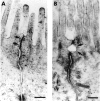Augmented increase in tight junction permeability by luminal stimuli in the non-inflamed ileum of Crohn's disease
- PMID: 11839706
- PMCID: PMC1773145
- DOI: 10.1136/gut.50.3.307
Augmented increase in tight junction permeability by luminal stimuli in the non-inflamed ileum of Crohn's disease
Abstract
Background: Crohn's disease is associated with deranged intestinal permeability in vivo, suggesting dysfunction of tight junctions. The luminal contents are important for development of neoinflammation following resection. Regulation of tight junctions by luminal factors has not previously been studied in Crohn's disease.
Aims: The aim of the study was to investigate the effects of a luminal stimulus, known to affect tight junctions, on the distal ileum in patients with Crohn's disease.
Patients: Surgical specimens from the distal ileum of patients with Crohn's disease (n=12) were studied, and ileal specimens from colon cancer patients (n=13) served as controls.
Methods: Mucosal permeability to 51Cr-EDTA and electrical resistance were studied in Ussing chambers during luminal exposure to sodium caprate (a constituent of milk fat, affecting tight junctions) or to buffer only. The mechanisms involved were studied by mucosal ATP levels, and by electron and confocal microscopy.
Results: Baseline permeability was the same in non-inflamed ileum of Crohn's disease and controls. Sodium caprate induced a rapid increase in paracellular permeability--that is, increased permeation of 51Cr-EDTA and decreased electrical resistance--which was more pronounced in non-inflamed ileum of Crohn's disease, and electron microscopy showed dilatations within the tight junctions. Moreover, sodium caprate induced disassembly of perijunctional filamentous actin was more pronounced in Crohn's disease mucosa. Mucosal permeability changes were accompanied by mitochondrial swelling and a fall in epithelial ATP content, suggesting uncoupling of oxidative phosphorylation.
Conclusions: The tight junctions in the non-inflamed distal ileum of Crohn's disease were more reactive to luminal stimuli, possibly mediated via disturbed cytoskeletal contractility. This could contribute to the development of mucosal neoinflammation in Crohn's disease.
Figures




References
-
- Olaison G, Sjödahl R, Tagesson C. Abnormal intestinal permeability in Crohn's disease. A possible pathogenic factor. Scand J Gastroenterol 1990;25:321–8. - PubMed
-
- Meddings JB. Review article: Intestinal permeability in Crohn's disease. Aliment Pharmacol Ther 1997;11(suppl 3):47–53. - PubMed
-
- Hollander D, Vadheim CM, Brettholz E, et al. Increased intestinal permeability in patients with Crohn's disease and their relatives. A possible etiologic factor. Ann Intern Med 1986;105:883–5. - PubMed
-
- Lindberg E, Söderholm JD, Olaison G, et al. Intestinal permeability to polyethylene glycols in monozygotic twins with Crohn's disease. Scand J Gastroenterol 1995;30:780–3. - PubMed
-
- May G, Sutherland L, Meddings JB. Is small intestinal permeability really increased in relatives of patients with Crohn's disease? Gastroenterology 1993;104:1627–32. - PubMed
Publication types
MeSH terms
Substances
LinkOut - more resources
Full Text Sources
Other Literature Sources
Medical
